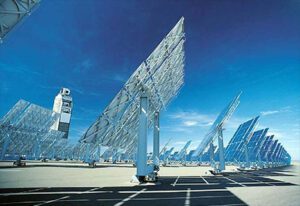Concentrated Solar Power Installations Increased 37% in 2009
 WASHINGTON, DC – The Solar Energy Industries Association (SEIA) just released the 2009 U.S. Solar Industry Year in Review, finding 2009 to be another year of strong growth despite the economic recession.
WASHINGTON, DC – The Solar Energy Industries Association (SEIA) just released the 2009 U.S. Solar Industry Year in Review, finding 2009 to be another year of strong growth despite the economic recession.
Overall U.S. solar electric capacity, including both photovoltaic and concentrating solar power installations, increased by 37 percent. This was driven primarily by strong demand in the residential and utility-scale markets, state and federal policy advances and declining technology prices. As a result, total solar industry revenue reached $4 billion, a 36 percent increase over 2008.
The solar industry contributed to the overall economy by adding 17,000 new jobs from coast to coast. The solar industry today employs 46,000 U.S. workers and supports an additional 33,000 jobs in other sectors.
“Despite the Great Recession of 2009, the U.S. solar industry had a winning year and posted strong growth numbers,” said Rhone Resch, SEIA president and CEO. “When the President looks back at how stimulus dollars were invested, he’s going to see that solar was one of the best returns on investments in 2009 for the American taxpayers. In addition to strong policies at the state and federal level, solar’s growth was driven by the emergence of new business models and declining prices. Consumers took notice that now is the best time to go solar.”
“SolarCity grew aggressively in 2009 based on increasing demand for its full-service solar offering, including financing options that can allow businesses and homeowners to pay less for solar power than they previously paid for electricity. The company has added close to 300 new workers in the last 12 months and has now completed or undertaken more than 7,000 solar projects,” said Jonathan Bass, spokesperson for SolarCity based in Foster City, Calif.
“Demand for solar power is growing at a tremendous rate,” said Ron Kenedi, Vice President of the Solar Energy Solutions Group of Sharp and member of SEIA’s Board of Directors. Sharp’s U.S. headquarters is in Huntington Beach, Calif. “Our residential, governmental, commercial and utility customers want clean and reliable power. We have responded to this demand, and in doing so, have created a wealth of high tech jobs here in the U.S. Additionally, for every new job in our factory, many more are being created in the field – in areas such as design, sales and construction – where the systems are being installed.”
“Building off the successes of 2009, we expect 2010 to be a breakout year for the U.S. solar industry,” added Resch. “The right policies and industry innovation continue to drive solar’s growth across America. Now we’re talking gigawatts of solar, not megawatts.”
Report highlights for 2009 included:
Growth in added solar electric and solar thermal capacity
• Solar electric capacity growth (including both photovoltaic and concentrating solar power technologies) for 2009 was 37 percent more than 2008.
• Solar water heating grew by 10 percent over 2008.
• Solar pool heating growth was 10 percent less than 2008 growth, reflecting the decline in construction and housing markets.
Increased capacity by solar technology
• Photovoltaic installations (grid-tied) grew by 38 percent
• Solar water heating grew by 10 percent annual over 2008.
• Concentrating solar power sector had three new plants come online in 2009. Cumulative CSP capacity in the U.S. reached 432 megawatts with a development pipeline totaling more than 10,000 megawatts.
Capacity by market segment
• Residential grid-tied PV solar installations showed particularly strong growth, doubling from 78 megawatts to 156 megawatts.
• Non-residential grid-tied PV solar installations grew 2 percent less than in 2008.
• The utility market saw notable growth, with utilities tripling their rate of grid-tied PV capacity additions from 22 megawatts to 66 megawatts. The total utility-scale pipeline (across all solar technologies) reached 17 gigawatts, enough to power 3.4 million homes.
Jobs and Revenue
• The solar industry contributed to the overall economy by adding 17,000 new jobs.
• Solar industry today supports 46,000 U.S. jobs and supports an additional 33,000 jobs in other sectors.
• Growth in the industry resulted in a 36 percent increase in overall revenue, totaling nearly $4 billion.
If you enjoyed this post, make sure you subscribe to my RSS feed!

